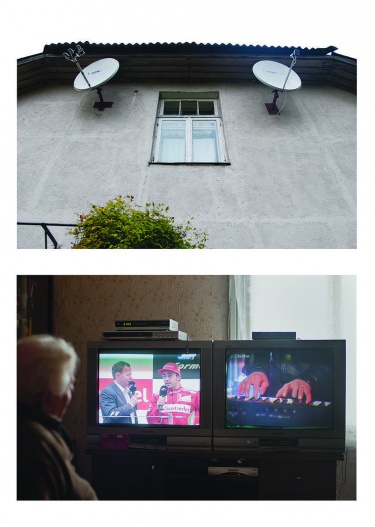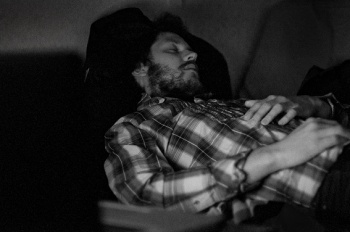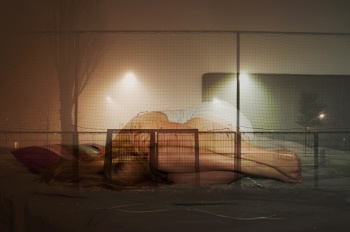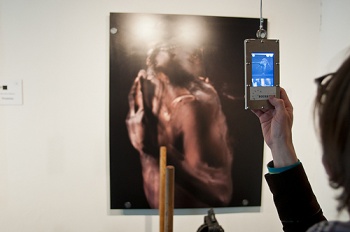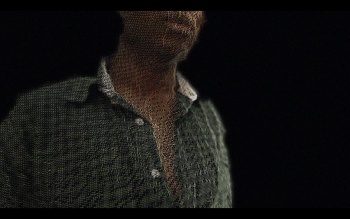Janis project proposal: Difference between revisions
No edit summary |
|||
| Line 1: | Line 1: | ||
[[Image: roots of misscomunication.jpg |right | [[Image: roots of misscomunication.jpg | thumb | 375px |right|none]] | ||
== Tentative Title == | == Tentative Title == | ||
| Line 22: | Line 22: | ||
== Relation to my previous practice == | == Relation to my previous practice == | ||
[[File:slothful_dreams.jpeg | thumb | 350px | [[File:slothful_dreams.jpeg | thumb | 350px | right | none]] | ||
In my previous practice I was obsessed with different visual experiments, editing and postproduction techniques. I came up with short fictional stories that I was dreaming about or simply imagining. I was curious how can I visualize those stories by using photographs or moving images. | In my previous practice I was obsessed with different visual experiments, editing and postproduction techniques. I came up with short fictional stories that I was dreaming about or simply imagining. I was curious how can I visualize those stories by using photographs or moving images. | ||
Revision as of 21:05, 20 November 2012
Tentative Title
Personal judgment. Finding the form
General Introduction
Looking back at my previous practice I realized that most of it is connected with technical explorations of the digital photographical medium and constructions of imaginative worlds, fictional spaces and behavior of people. I have been interested in the absurdity and the fact how to interpret and visualize it, in a way constructing my own absurdism.
At the moment I would like to take the opposite way and look for kind of an absurdity in the real life. I would like to use images from my personal family archive as the source material for inspiration.
Prepare some sketches with possible topics and see what could I create out of that in the later stage.
My personal motive would be to investigate some things in my family and the behavior of the members. I would need to talk with my grandmother and record some of her memories about the family life, reveal some historical facts, because that could possibly help me to understand some miscommunication issues between the family members in nowadays.
Thinking about my instinctive actions of image making in the past years and looking into what is in my archive right now, I would claim that most of the interesting things for myself are related to my personal observations of my relatives, documentations of their daily life, and their environment. These images are like notes about subjects that I find interesting or situations that confuses me or makes me wonder and appreciate. In a way those are normal subjects which can be referred to a broader context. For example, objects that represent repetition and obsession with something, like my grandmother and her cactuses or my uncle who collects horns and hunting trophies. These things, could serve as a part of my observations and registration material. During my investigation process I am interested to study and observe theses little things and create bridges between them, for example, how they are contrasting in the real life..
Relation to my previous practice
In my previous practice I was obsessed with different visual experiments, editing and postproduction techniques. I came up with short fictional stories that I was dreaming about or simply imagining. I was curious how can I visualize those stories by using photographs or moving images.
The video "My slothful dreams" was created in an experimental process as a playful visualization of a recent dream. A tired man with a big bushy beard stands in the bathroom and looks at himself in a mirror. He feels ugly. He wants to shave the beard but he is too shiftless and lazy to do it. He takes off his shirt looks around and suddenly instead of taking a razor he has an idea to try to shave off the beard with his nails and finger tips. He tries to touch his face and the finger tips are becoming razor sharp as well as the nails. The surreal and absurd situation contrasts with a dash of humor within the story line where our reality goes hand by hand with our dreams. The dream translated it self during the editing process and the short storyline established towards laziness and unreal wish theme about avoidance and imagination.
By making "My slothful dreams", I was interested to explore and visualize the absurd situation that I saw in my dream. As the outcome I made an stop motion image sequence that displays the fictional reality.
After that I continued with the dream theme and the explorations of the digital lens based media and experiments with digital images. I was referring to the several exposure technique by overlying images one on each other. I was mixing together several visuals, women characters who are lost in their space and nature landscapes. I was trying to construct the connection and search for an ambiguous space in-between where the character and the two environments would some how fit together. I was pleased by the fact, how two different spaces can merge together and create a third one, construct an photographical, even photorealistic, aesthetically nice imagination.
In the following term I was interested to investigate how a software can generate visual information in between, knowing two coordinates and creating the third one. The visual material consisted from a lot of still images, the sequence was a bit reformed and processed on a computer by using after effects software. There were two results, an high quality, large scale printed image and a fast moving image sequence, both displaying a digitally generated movement. The motion was corrupted by the software, in a way representing time and deforming the natural body moves. The video is the hidden augmented world of the work, it can be revealed when a smartphone is directed at the photograph. On the digital screen the hidden reality unfolds engaging the spectator and resulting in a strong connection with the photograph it self.
Again, it explored the boundaries of lens based medium, unfolded another way of a visual interpretation and raised a question why the post-photographical qualities are interesting in nowadays? It is yet another way of manipulating reality, another way of experiencing it by using these contemporary tools. At the moment I am questioning myself, what qualities from these experiments I can borrow and put into my visual language grammar section, what does it add to my working methodology?
In the last trimester of the first year, I merged my ideas with Javier Lloret and we created the project "Human Stock". It is a video presentation about a fake media company which actually does not exist. In the video actors are describing the utopian plans about the platform and how it is going to change the visual media industry.
The platform is offering an online stock library of 3D photorealistic visuals of real human beings. Customers from the industry can browse an online store, purchase and download any of the 3D model stock visuals. It has a potential to create wholly new markets and employment opportunities, and change the visual language of perceiving images.
Conversely, the Human Stock is offering to anyone the opportunity to have their body digitized for the 3D stock library, using the automated, easy-to-use 3D full body scanner booth. Each model/supplier can earn a fixed percentage of the revenue generated with each download and use.
The video advertisement consists of interviews in which the founders explain how it works and some of the users are giving feedback of their experiences. It is a trailer/mockumentary which gives a short description about what Human stock is and how it works.
The fake company has been created as an inspiration by Apple and other powerful companies and service platforms, admiring their aims and products. Sometimes they are producing utopian things, and representing them in an even more bizarre level, they are real but kind of "on the edge" with the reality, revolutionary as they say. Promising one thing, but behind it stands something else. For example a track for online marketing tools.
Any how, it is interesting to see how people are reacting to these kind of revolutionary services and products. Also, what kind of questions are raised after seeing Human Stock "proposal"? Do people believe that it is a real company or just a fiction? How far can I go to make people believe and convince them that its harmless? Do people understand that it is a fiction or it does not matter?
With the technology that is out there some company could actually provide this service. Would people use it and do not think about the consequences? For example, that it is possible to loose the track of their personal digital image and the way how and where it has been used? How much control do we have currently with the real online services where we share our images and information with others?
Practical steps
The plan
My action plan is to go back home during the winter vacation and spend some days together with my grandparents at their place. I want to work with my grandfathers photo archive, digitize it and pick out some subjects, try to look for inspiration over there. Organize them by relevance and importance. The topics of the stories will be, for instance, issues that refer to their daily life, the things that raise questions in the photos. I would like to document these things in an observational manner, graphically, maybe create still life compositions from their things.
Sketches for the possible trigger stories
+For more than 50 years they have been living in the east countryside of Latvia. For almost all of these years their main occupation was to work with flowers, grow and sell them. My grandmother simply loves any kind of flowers, especially cactuses. At certain period she had one of the biggest collections in Latvia. Still, she has quite a large greenhouse. Her passion about the flowers is still there also the knowledge about them, repetition of the processes is most important for her.
+My grandfather has been always obsessed with three things, hunting, cars and documenting family. I will try to recombine, adjust and recreate it in the visual images. In the archive I found a lot of images where he is posing with his catch. Also I found a lot of images with kids, who are holding guns, dead animals or birds. Obviously, for him it was an important issue to document it.
+My grandmothers passion about flowers, taking care of them and my grandfathers passion about hunting, having the catch. The opposite approaches how to deal with the nature;
+There was always a hunting dog at home. Always. During the summers of my childhood I used to visit my grandparents. I always had a lot of adventures over there. Once, the summer finished pretty early and painful, one of the dogs got crazy and attacked me. It was biting me really hard, later I had a lot of scars, especially in my face. I remember, couple of years after that, I was drawing my self-portrait for my grandmother. I was highlighting lines on my forehead and nose, they were in a reddish blue color till my teenage years and I still have them, only the color is gone.
+Other ideas that come up in my mind right now are raising from my childhood memories.. the memories that I have from my grandmothers house and the surrounding things, trees, the well, the dry toilet, the shed..
+The other thing what is interesting about my grandmother is her passion about crossword puzzles, how she is observing and categorizing things by creating her own notebooks - encyclopedias about different subjects. For example about F1 drivers or celebrities.. writing things down and collecting them in a specific way, these notebooks can help to solve the crossword puzzle questions.
+The issue about my uncle who does not want to speak in front of the camera is like a censorship for his appearance in public. Reflecting to a larger context, by displaying his environment and the things that are around him it would revile his personality.
+The biggest dream of my grandmother is to see the whole family together, especially the three sons, sitting by one table. Unfortunately, because of their hard characters, they were always getting in an argument each with another and for last couple of years, maybe even ten, they are not talking anymore. Even not willing to talk.
+For example, the biggest problem in the family for last 10 years has been miscommunication. Actually, it has been always there. In a way, no one is really attracted each to another as a family member, it is sort of an ego thing, everybody are pretty happy independently and even do not aim for being together as a one whole group. Which probably is nothing special.
Possible outcome forms
I have the tension to digitize the archives and bring up some stories, express thoughts and cultural aspects. My practical work would be related to the aspect of recreating, reorganizing and dealing with the visual material and ideas, old ideas and stories in a new visual interpretation.
The final form of the output at the moment can be anything, visual installation, a book, visual essay, prints, it depends of the process and how it is going to develop. The process of decontextualization is important. In the end of the day my aim is not only to show my family photos.
The aim would be to approach the idea of working with a preexisting material, edit and organize the visuals, add new images and context by using the input material of stories and look for new forms how to work with the medium of still and moving images.
At the moment I would love to experiment with lenticular print possibilities and create some light boxes. I am always amazed by the possibilities of lenticular prints, the option to materialize various digital recombinations show on one surface, for example, motion, 3D effect, notion of time, etc. I am interested in back light box format, because it is the closest possible way how to exhibit images that have been reproduced on a display, I find there a connection between the digital image that I have observed on a digital computer screen.
References
Theory:
Nicolas Bourriaud, Postproduction 2002;
Nicolas Bourriaud, Relational aesthetics;
Lev Manovich, New Language of Cinema;
Kant after Duchamp - Thierry de Duve;
Nestor Garcia Canclini, Remaking Passports; Visual thoughtin the debate on multiculturalism;
David Joselit, What to do with Pictures, October 138 about Digital Arts;
Csikszentmihalyi, M. Setting the stage. About creativity. 1-21
De Mul, J. (2009). The work of art in the age of digital recombination. Digital Material. Amsterdam: Amsterdam University Press. 95-106.
Kessler, F. (2009). What you get is what you see: Digital images and the claim on the real. Digital Material. Amsterdam: Amsterdam University Press. 187-197.
New Media, Old Art Forms: Art in the Age of Digital Reproduction, Department of English Studies, University of Strathclyde;
Artists:
Duane Michals
Thomas Ruff
Banksy
Oliver Leric
MacDonaldStrand
Ryan Mcginley
Omer Fast
Kirby Ferguson
AES+F
Austin Kleon
Veronique Bourgoin
Richard Billingham
Fabio Messias
Donald Weber
Adam Broomberg & Oliver Chanarin
Erik Kessel
Christian Patterson
Movies:
Good copy, Bad copy
Press pause, play
Vvversions. Oliver Laric
Everything is a Remix
Exit through the gift shop. Banksy
Hugo
Who gets to call it art. Henry!

